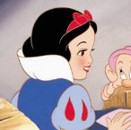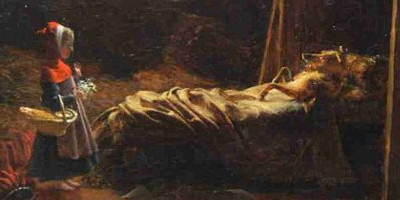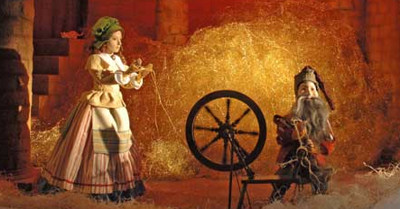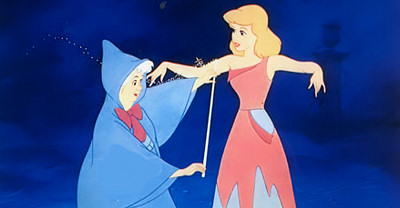The Gruesome Origins of 5 Popular Fairy Tales

We know what's you're thinking. "What the hell is Cracked writing articles about fairy tales for? That's kids stuff! Give us more articles about the Top 10 Transformers Characters, or Worst Dressed Thundercat!" And that's good, because that means our Spyware technology is getting better than ever.
The thing about fairy tales, though, is that they weren't always for kids. Back when these stories were first told around campfires and in taverns in some medieval village there were very few kids present. These were racy, violent parables to distract peasants after a hard day's dirt farming, and some of them made Hostel look like, well, kid's stuff.
Little Red Riding Hood: Inter-Species Sex Play, Cannibalism

The Version You Know
Mention the words "fairy tale" to someone--if they don't think of gingerbread houses, or possibly a certain bar they know, they think of this story. Little Red on her way to grandmother's house meets the Big Bad Wolf and stupidly tells him where she's going. So he gets there first, eats Grandma, puts on her dress and waits for Red.
She gets there, they do the back-and-forth about what big teeth he has, and he eats her. Then, a passing woodsman comes and cuts Red and Grandma out of the wolf, saving the day.
What Got Changed
Most modern versions of fairy tales come from two sources: The Grimm Brothers from Germany, and Frenchman Charles Perrault, the collector of the "Mother Goose" tales. The big change they made to this one was the ending. That woodsman showing up seemed a little like a third act re-write of a movie due to bad test screenings, didn't it? Where the hell did the woodsman come from?
Well, the woodsman was a later addition to the tale. In the early versions of the story, Red and her Grandmother are dead. The. Goddamn. End. Also, in most versions the woodsman cuts the pair out of the wolf's belly, where they're mostly none the worse for wear despite being eaten, which implies to us the wolf in that story world eats like some sort of python, by unhinging its jaw and swallowing prey whole. Suspension of disbelief only goes so far.
 Much earlier versions also liked to spice up the sexuality angle of the story, by having Red outwit the wolf by performing a striptease for him while he's lying in bed dressed as her Grandmother, and then running away while he's "distracted" (Note to any young girls out there: if you are ever abducted and menaced by someone, DO NOT DO THIS).
Much earlier versions also liked to spice up the sexuality angle of the story, by having Red outwit the wolf by performing a striptease for him while he's lying in bed dressed as her Grandmother, and then running away while he's "distracted" (Note to any young girls out there: if you are ever abducted and menaced by someone, DO NOT DO THIS).
Wait, it gets worse. This is the most horrifying bit that got filtered out before the tale reached both the Grimm's and Perrault (and in fact, only made it into a few written texts). In this version, the Wolf dissects Grandmother, then invites Red in for a meal of her flesh, presumably with a side of fava beans and a nice Chianti. Then he eats her, too.
Story's over! Sweet dreams, little Sally!
Snow White: Prince Pedophile, More Cannibalism

The Version You Know
Well, you've all seen the movie, you know how this goes. Evil step-mom hates that her daughter is prettier than her so she tells one of her men to take out to the woods and kill her, and bring back her heart as proof. He can't follow through, so he tells her to run away and never return.
Snow White flees, and she falls in with seven friendly dwarves. The step-mom finds out and sneaks her a poison apple. Snow goes into a coma until a handsome prince rescues her and they live happily ever after.
What Got Changed
 In the Disney film the wicked step-mother winds up dead (she falls off a cliff). So that's pretty hardcore we guess. It's got nothing on the Grimm version, though, where the step-mother is tortured by being forced to wear red-hot iron shoes, and made to dance until she falls down dead (you can picture the puppet thing from Saw spelling this out for her over a closed-circuit monitor).
In the Disney film the wicked step-mother winds up dead (she falls off a cliff). So that's pretty hardcore we guess. It's got nothing on the Grimm version, though, where the step-mother is tortured by being forced to wear red-hot iron shoes, and made to dance until she falls down dead (you can picture the puppet thing from Saw spelling this out for her over a closed-circuit monitor).
The issue of Snow's actual age is a point of contention as well. The Grimm's explicitly refer to her as being seven years old when the story starts, and while there's no firm indication of how much time has passed, it's no more than a couple of years. So unless that's an eight-year-old Prince Charming who comes along and rescues Snow, we're backing away from this one before we become the subject of an NBC reality show.
The biggest change, and the bloodiest, is step-mom's ... unusual eating habits. Namely, when she asks her man to bring back the heart of Snow White, she isn't just after proof the girl is dead. She wants to eat it. Depending on the version of the story, the Queen asks for Snow's liver, lungs, intestines and pretty much every other major internal organ, up to and including one gruesome version where she asks for a bottle of Snow's blood stoppered with her toe.
And if you think the fairy tales were gruesome back then, you should have seen the merchandising tie-ins.
Rumpelstiltskin: Dismemberment, Dead Toddlers

The Version You Know
There's never been a Disney version of this one, but you've probably heard it before. A miller has a beautiful daughter who he claims can spin straw into gold. A passing noble decides to call the miller on his shit and takes the girl and locks her in a tower and tells her to get spinning, presumably hoping to cause a collapse in the precious metals market.
Fortunately she's helped by a little gnome who shows up and offers to help in exchange for a small trinket. This goes on three nights, and by the third night the girl is promising the little man her first born child in return for his help. On the third morning, the king decides to marry this pretty girl who can produce gold out of dry grass.
They inevitably have a son, and the little gnome shows up demanding him. Being nothing if not fair, he'll give the girl three days to guess his name. If she can, she keeps the kid. She tries everything but comes up short, until a passing woodsman overhears the gnome bragging about how he's so clever no one will guess his name is Rumpelstiltskin. He immediately tells the queen, who springs it on Rumpelstiltskin, who's so pissed off he throws a tantrum and runs away, presumably to ply his poorly thought-out scam in another town.
What Got Changed
 In the Grimm brothers' version, taken from the oral tradition, the little man is so pissed off he stamps the floor in his little hissy fit, and gets stuck. And then, like some insane version of a Will Ferrell skit, he pulls so hard to free himself that he tears himself in half. Now, if our names were Rumpelstiltskin and some dizzy miller's daughter had just told the whole damn room, we'd be pissed too, but we don't think we'd get dismemberment-angry.
In the Grimm brothers' version, taken from the oral tradition, the little man is so pissed off he stamps the floor in his little hissy fit, and gets stuck. And then, like some insane version of a Will Ferrell skit, he pulls so hard to free himself that he tears himself in half. Now, if our names were Rumpelstiltskin and some dizzy miller's daughter had just told the whole damn room, we'd be pissed too, but we don't think we'd get dismemberment-angry.
Not to mention, in the really early versions of the tale, Rumpelstiltskin launches himself at the girl in a rage and gets stuck ... um ... in her lady parts. Seriously. The palace guards all have to come and pull him out, which must have made for some awkward looks afterwards.
Also, in a depressingly large number of versions, the child is killed anyway, either by Rumpelstiltskin himself, or the guards, or someone. They weren't big on happy endings in the Dark Ages. Plague will do that.
Sleeping Beauty: Coma Sex

The Version You Know
Sleeping Beauty is the story of a young Princess who is cursed by an evil witch so that she will prick her finger on a spindle and die on her 15 birthday. The old woman does this because she wasn't invited to the party celebrating the girl's birth, where other good fairies/wise women are bestowing gifts upon her. Fortunately, one still hasn't given her a gift, and so tempers the curse--the Princess won't die, she'll just fall asleep for 100 years. We guess she did what she could, but still, a pretty major downer for the party.
Of course the King orders all spindles burned, plunging the kingdom into a fashion nightmare, but with the inevitability of fairy tale logic bearing down on her, the princess manages to find the one working spindle in the kingdom, and pricks her finger on her 15 birthday. She falls asleep for 100 years, until a dashing young Prince comes along in timely fashion and kisses her, breaking the spell. Everyone lives happily ever after.
What Got Changed
The first major departure in this from the version we know today is when the Princess pricks her finger on her 15 birthday. In earlier versions the Princess instead gets a piece of flax caught under her fingernail which pricks her and puts her to sleep. This might seem like a small difference but it becomes important when you consider the other major, and unsettling, change to the story.
 Previous versions of the tale have the Prince who finds Sleeping Beauty think she's so damn beautiful he just goes ahead and has his way with her right then and there. Yes, while she's still comatose.
Previous versions of the tale have the Prince who finds Sleeping Beauty think she's so damn beautiful he just goes ahead and has his way with her right then and there. Yes, while she's still comatose.
If that's not disturbing enough, the rohypnol-style coupling leads to a pregnancy, and the Princess gives birth to twins, all while asleep. One of the babies, seeking momma's milk, sucks on her finger and dislodges the flax, waking her, at which point we imagine she had a few questions.
Cinderella: Mutilation, Sex, More Mutilation

The Version You Know
When they talk about "Fairy Tale Endings," they're almost certainly referring to this story. Or possibly some sort of football game. This is the dream of every little girl (and some little boys) that one day they too can rise up from the dirt and become a pretty pretty princess. You all know it; the step-mother and step-sisters who hate the beautiful Cinderella, and make her work all day, until one day a Fairy Godmother shows up and gives Cinderella pretty clothes and a pumpkin coach and sends her to the ball where she falls in love with the Prince.
But at the stroke of midnight it all ends, and she runs home, leaving only her glass slipper behind. The prince searches the land, finds Cinderella, the shoe fits, and they live happily ever after.
What Got Changed
 This one goes way, way back, having been told across cultures for thousands of years before being made into numerous Hollywood movies. The identity of the Fairy Godmother changes often, and in fact she only showed up in Perrault's version, along with the pumpkin coach and the mice attendants which were all used in the Disney version. There's even a Chinese version of the story from around 850 AD, where "Yeh-Hsien" is given gold, pearls, dresses and food by a giant talking fish.
This one goes way, way back, having been told across cultures for thousands of years before being made into numerous Hollywood movies. The identity of the Fairy Godmother changes often, and in fact she only showed up in Perrault's version, along with the pumpkin coach and the mice attendants which were all used in the Disney version. There's even a Chinese version of the story from around 850 AD, where "Yeh-Hsien" is given gold, pearls, dresses and food by a giant talking fish.
A famous difference in many versions of the story is the "glass slipper." Authorities on fairy tales (who you tend not to see at parties) disagree about whether Perrault's slipper was made of glass or fur, as the words in French (verre and vair respectively) are pronounced almost the same. It's kind of important, because if the Prince was wandering the land looking for a lady with the perfect "fur slipper" ... well, it doesn't take Freud to figure that one out, and suddenly the Prince doesn't look so noble.
One thing Perrault left out that the Grimm's delighted in putting back in was the violence. The sisters, desperate to fit into the slipper, mutilate their own feet, cutting off the toes and heels all described in exquisite Germanic detail. When the Prince eventually realizes Cinderella is the one for him, birds peck out the sisters' and mother's eyes for their wickedness.
You can probably understand why Disney went with Perrault's version for an adaptation.
Learn about the horrors behind some other stories you grew up with in The The 5 Creepiest Urban Legends (That Happen to be True) or, read famous pornography describer Mike Swaim's blow by blow account of a sex tape far more terrifying than anything contained in any tale or legend.